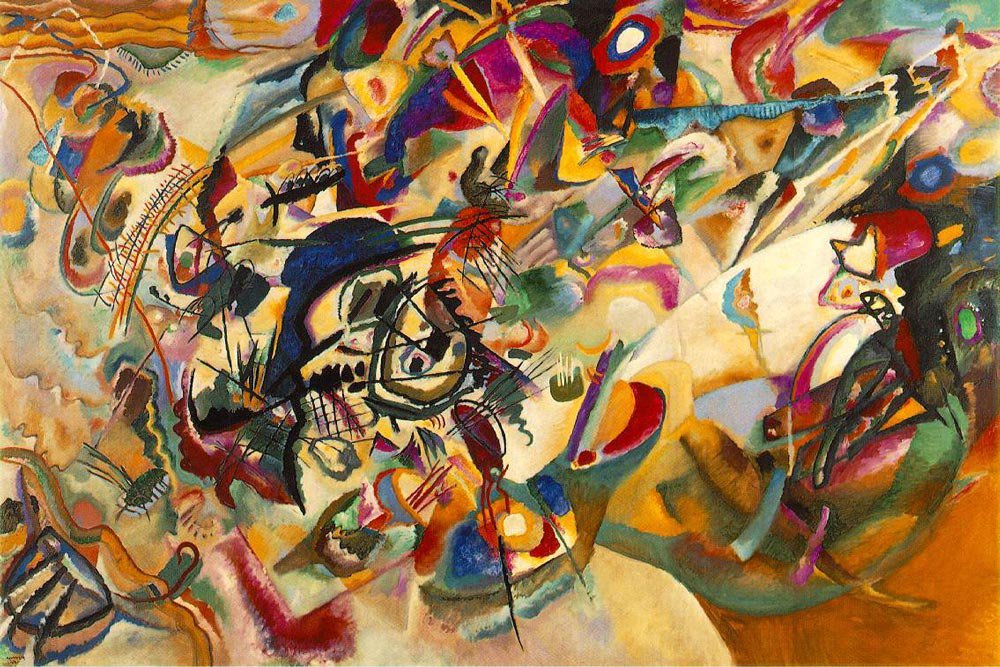SYNESTHESIA.
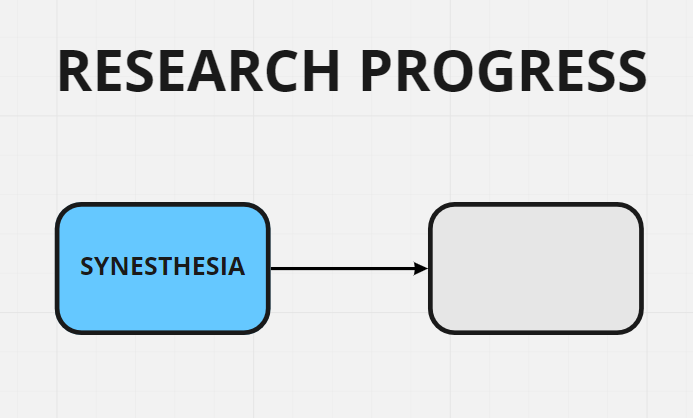
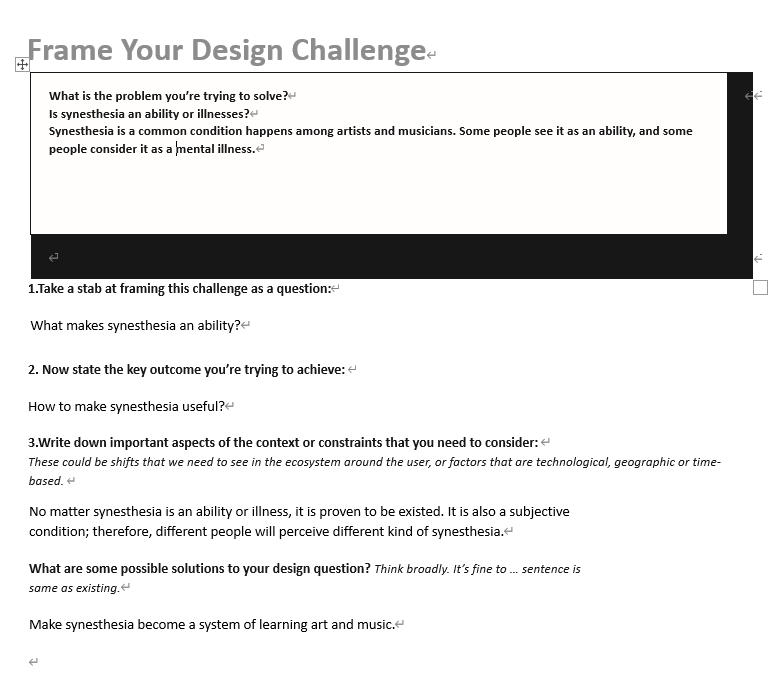
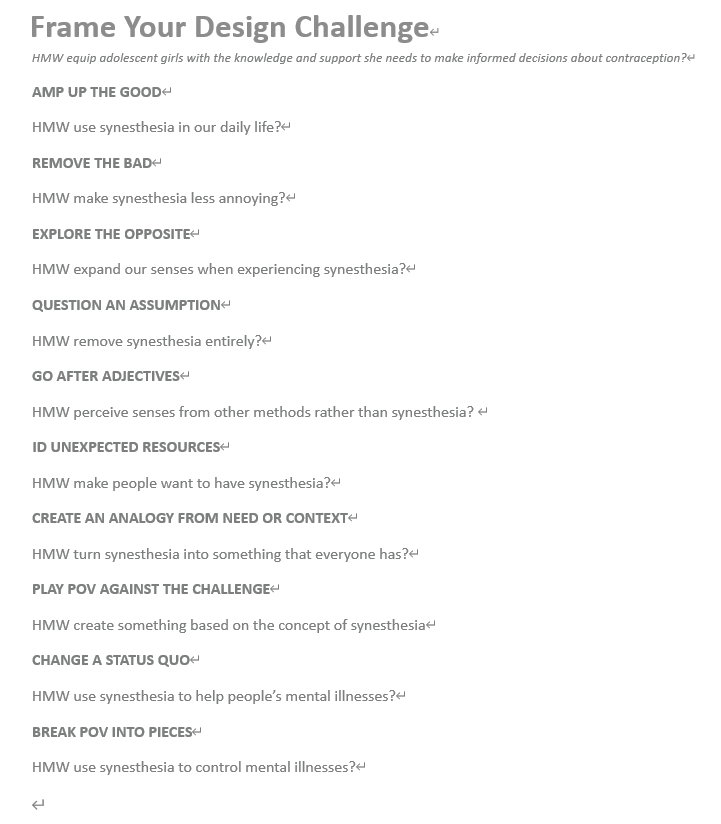
I created a set of questions for the research by using Kipling’s Checklist(5W1H):
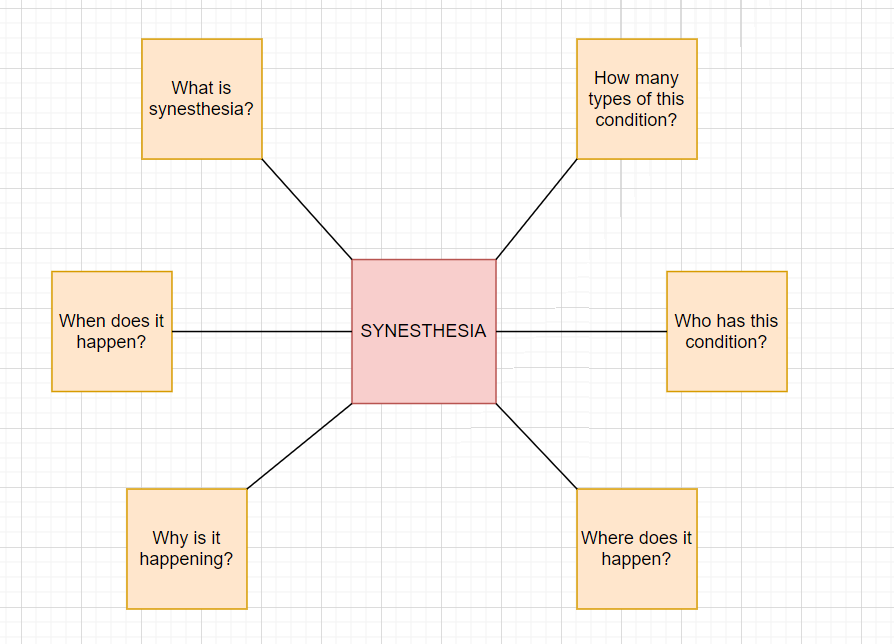
After two weeks of exploring different topics for FMP, my final interest lands on ‘senses’.
The first related theme I can think of is synesthesia. This is an explanation of what it is:
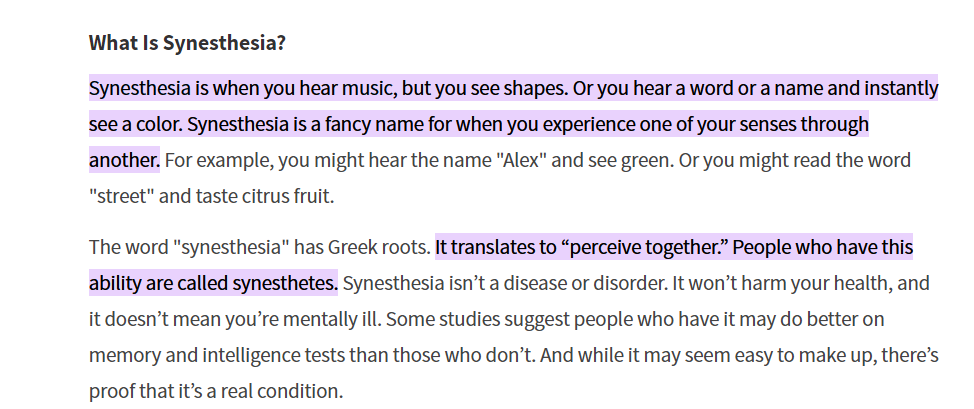
I came across this theme a couple of times, but I didn’t get a chance to dive into it and do something around the topic, and I figure this might be an excellent opportunity to do it.
The first thing I researched was the types of synesthesia. According to Arefa Cassoobhoy, here are some typical types of synesthesia, see below:
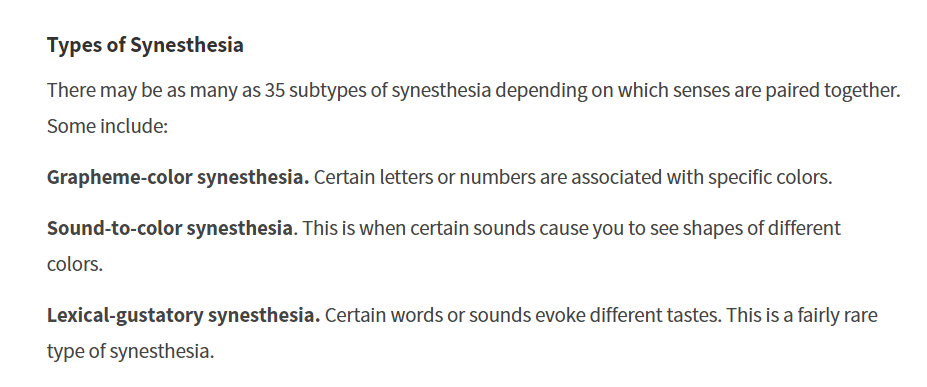
It is funny. I just found out there are so many types of synesthesia, and I thought there was the only one in which you hear sounds and see colours. Now I understand that three common types of synesthesia are also associated with three different senses: sound, visual and taste.
Here is a study from:
UKEssays. November 2018. Synesthesia: A Unique Perspective on Life. [online]. Available from: https://www.ukessays.com/essays/psychology/synesthesia-unique-perspective-life-9793.php?vref=1 [Accessed 14 October 2021].

In conclusion, synesthesia is still a myth because it appears in both neurological and psychological studies. Having synesthesia doesn’t mean you have negative effects, and some studies show that it helps people memorising things.

Based on the paragraph above, there are two types of synesthesia:
Projective is when synesthetes can see the colours, and associative is when synesthetes can feel the colours.
The study also uses grapheme-colour synesthesia as an example:

It is challenging to research all three types of synesthesia at once, so I decided to go through what each synesthesia is briefly and then talk about the issues that it is causing.
Grapheme-colour synesthesia.
This is a brief introduction to this type of synesthesia, written by Marc:

NoelleTheFirst explained her experience of grapheme-colour synesthesia:
Interestingly, her acknowledgement of colours and numbers are very similar to my own experience. For instance, I always think ‘9’ is red, and ‘8’ is dark blue or purple. Furthermore, I also associate dates with colours. For instance, Tuesday is red, Wednesday is green, and Friday is yellow. This phenomenon is fascinating, and I want to figure out how it happens.
Sound-to-color synesthesia.
Here is STEPHEN E. PALMER wrote an article:
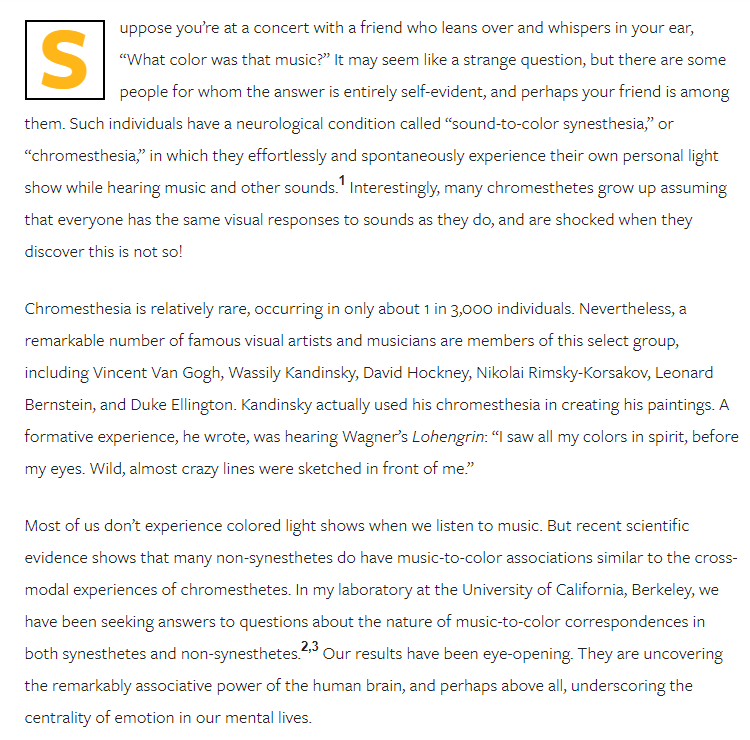
To sum it up, Sound-to-colour synesthesia is also known as ‘chromesthesia’. Its name already describes the concept of this condition: People can associate colours with the sounds they hear. Based on Stephen E. Palmer’s work, we understand that this is a rare condition. Many people who have experienced this are famous artists or musicians, such as Vincent Van Gogh and Wassily Kandinsky.
Here is an article was written by Renée B. Miller, focusing on Wassily Kandinsky’s experience of synesthesia:

Here is Kandinsky’s work:
This is an excellent video reflection based on Kandinsky’s work:
Lexical–gustatory synesthesia.
Lexical-gustatory synesthesia is an attractive condition because instead of hearing and seeing, it affects synesthete’s tastes.
This is a short paragraph posted on the synesthesia tree:

In summary, people taste flavour by receiving words through hearing, speaking, reading or thinking about it. Data shows that not many people experience this type of synesthesia, but it is not rare because there is no standardised method to determine it.
Here is a fascinating study was written by Colizoli Olympia, Murre Jaap, Rouw Romke (2013):

The paragraph describes the certain conditions of Lexical-gustatory synesthesia. For instance, most of the time, the synesthete will only taste one sound at a time, and sometimes they can taste the flavour of the food when thinking about it.
Speaking of my personal experience, I could taste the food only by thinking about it, but it started to deceased when I grew up.
CONCLUSION.
After researching into synesthesia, I am now able to fill in the answers on the question set:
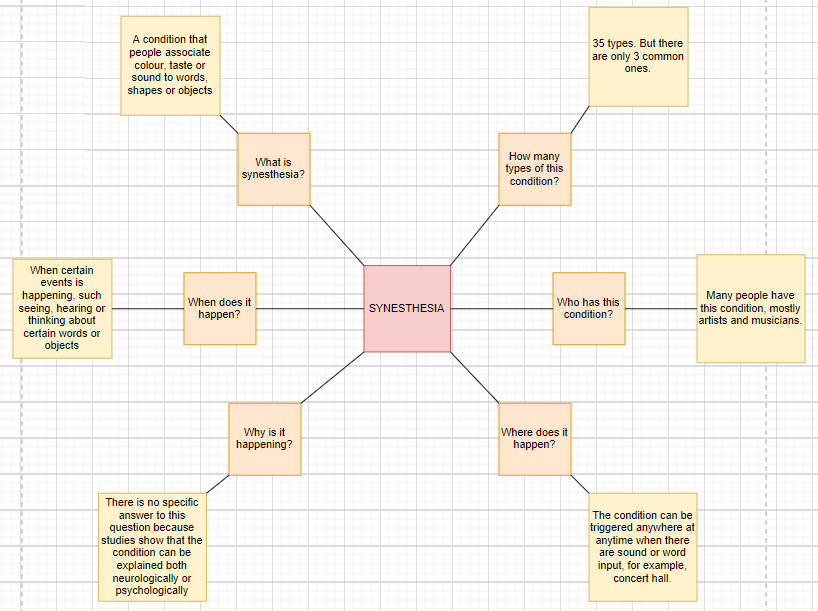
I spoke to my tutor Danny about this topic, and he suggested I start thinking about issues that may cause or relate to synesthesia. Therefore, I will be doing research and writing paragraphs based on the research I have found to see if I can discover anything interesting for my final major project.
Dissertation 1.
At this stage, I am going to write the first minor dissertation to address the issue and help me moving forward:
Is synesthesia a beneficial condition?
Based on the research, people believe that synesthesia is beneficial because it helps to memorise things without any side effects. Furthermore, famous artists such as Wassily Kandinsky, Vincent Van Gogh and Vladimir Nabokov benefit from synesthesia. However, some studies show synesthesia has strong connections with depression. Interestingly, Vladimir Nabokov, Wassily Kandinsky and Vincent Van Gogh are all suffering from depressions at some point in their lives. Although there is no clear evidence saying their synesthesia was caused by depression, it is clear that people who have mental illnesses are more likely to develop synesthesia.
The minor dissertation above provided me with a couple of questions:
What is the relationship between synesthesia and mental illnesses?
What are mental illnesses more likely to trigger synesthesia?
What can we do to help people who are suffering from this condition?
Are people suffering from synesthesia?
SYNESTHESIA & PTSD.
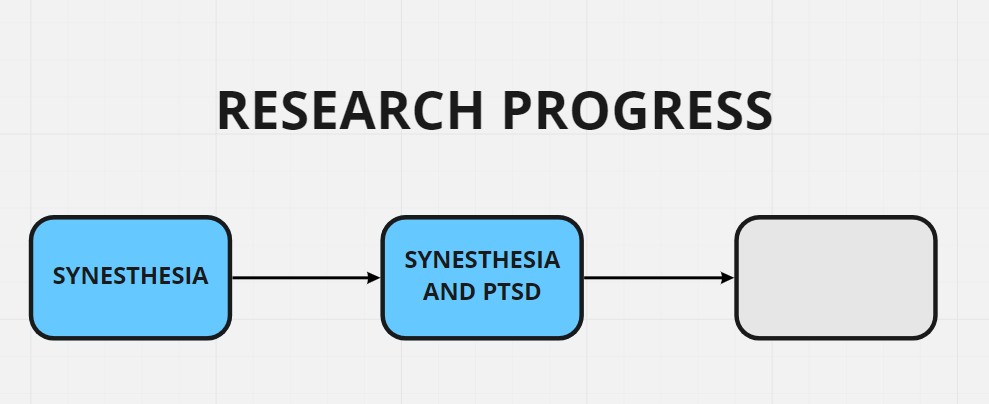
Regarding the questions above, I decided to look for the relationships between mental illnesses and synesthesia.
The first area I am looking into is Post-traumatic stress disorder (PTSD) because it is mentioned a lot during my synesthesia research.
A study was done by:
Hoffman, S. N., Zhang, X., Erlich, P. M., & Boscarino, J. A. (2012). Grapheme-color synesthesia and post-traumatic stress disorder: preliminary results from the veterans’ health study. Psychosomatic medicine, 74(9), 912–915. https://doi.org/10.1097/PSY.0b013e3182731007
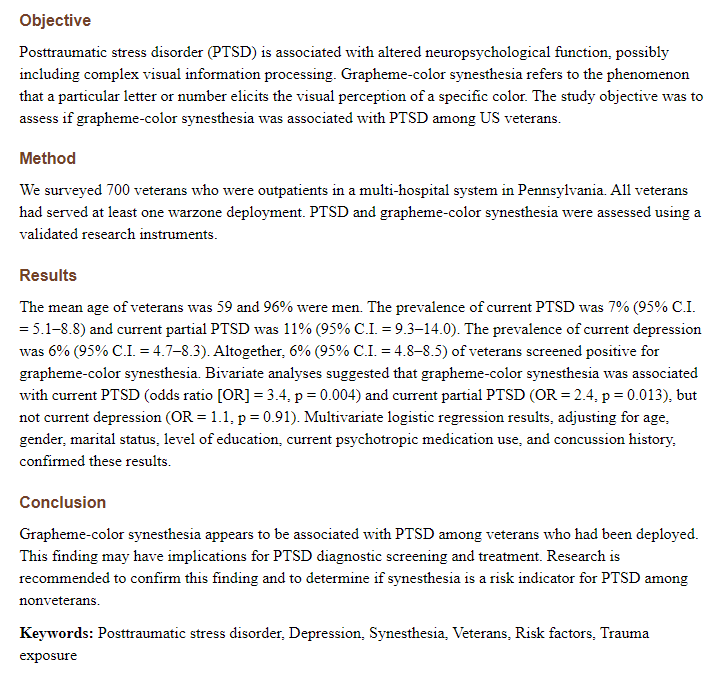
Based on the section above, we understand a strong connection between PTSD and Grapheme-colour synesthesia.
Berit Brogaard wrote an article on Psychology Today, suggested that synesthesia can be caused by traumatic brain injury:
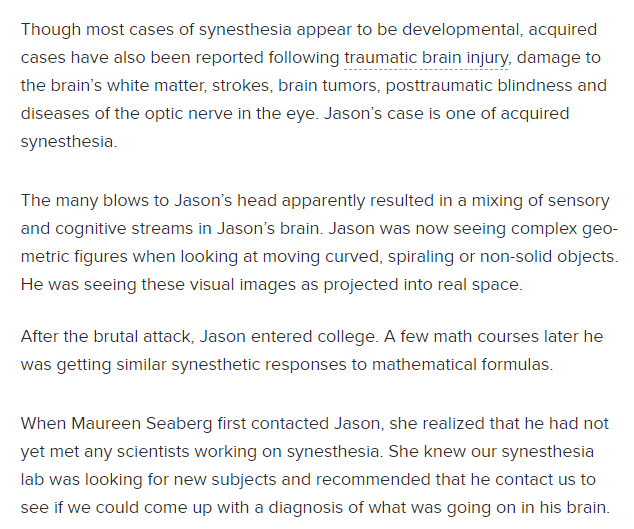
Dissertation 2.
After looking into PTSD and synesthesia, here comes to the second dissertation:
How does synesthesia trigger PTSD?
Studies show that synesthesia occurs when people come across specific colours or sounds associated with elements in their memories, which sometimes leads to PTSD. For instance, the shade of red can associate with the taste of blood; The sound of a helicopter can associate with the brownish battlefield; The siren can associate with police lights which are red and blue. The condition is dangerous because these colours and sounds are everywhere, making it unavoidable for people who have had trauma.
The minor dissertation leads to a few questions:
What can we do to avoid PTSD triggered by synesthesia?
What can we do to help people who suffer PTSD triggered by synesthesia?
What can we do to ease people who suffer PTSD triggered by synesthesia?
What can we do to cure people who have PTSD triggered by synesthesia?
SYNESTHESIA & SENSORY OVERLOAD

I cannot answer all the above questions because there isn’t enough data to support this topic.
However, these questions led me to a hypothesis: synesthesia could link to the exaggeration of the five senses. Luckily, I found some studies that support this hypothesis, and this specific condition is called sensory overload.
This is a phrase I found on BetterHelp.com that led me to discover the relationships between synesthesia and sensory overload:

WHAT & WHERE
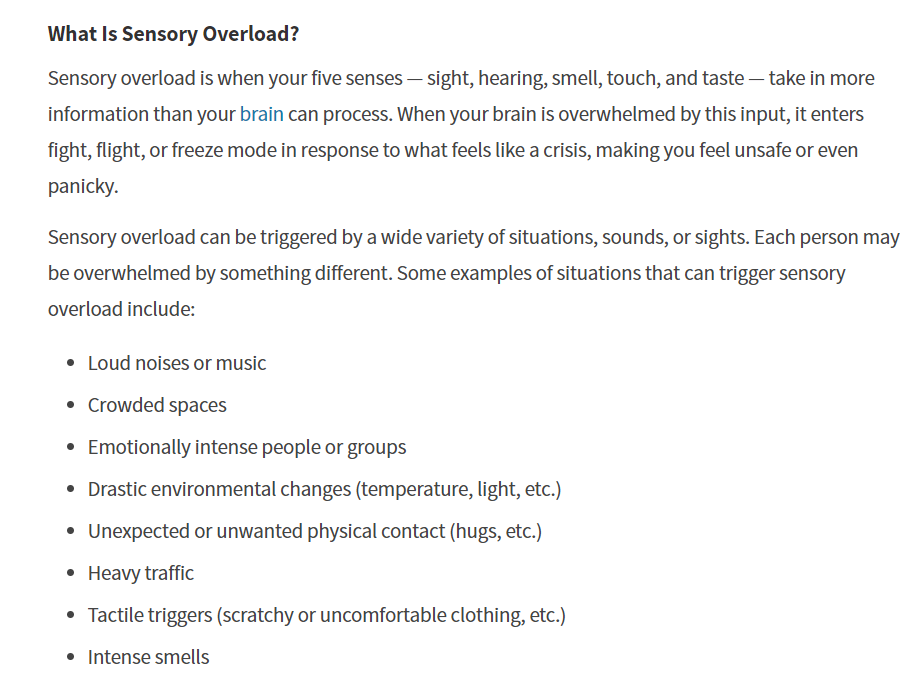
In summary, sensory overload is when more than one sense takes much more information than the brain can handle, leading to mental breakdown, making people feel unsafe and panicky. According to the description above, sensory overload can be triggered easily, which leads to severe consequences.
HOW
Here is an animation that shows how sensory overload feels like:
As we can see (perhaps feel) from the video, the person feels overwhelmed by his surroundings, and his five senses are taking so much input that it makes him feel extremely uncomfortable.
WHY & WHEN
In the video below, Purple Ella talked about symptoms of sensory overload:
Here are the typical sensory overload symptoms:
- Difficulty focusing
- Extreme irritability
- Restlessness and discomfort
- Overly excited
- A higher level sensitivity to sensory input
From an article written by JENARA NERENBERG , here are some tips she gave to handle sensory overload:

In summary, the author gave three methods that can help people with sensory overload.
Firstly, focusing on one sense could reduce anxiety. For instance, count your heartbeat.
Secondly, using medication and physician to support the condition.
Thirdly, using aesthetic treatments such as coloured lightings.
WHO
I have also found some people on Reddit who experienced both sensory overload and synesthesia:
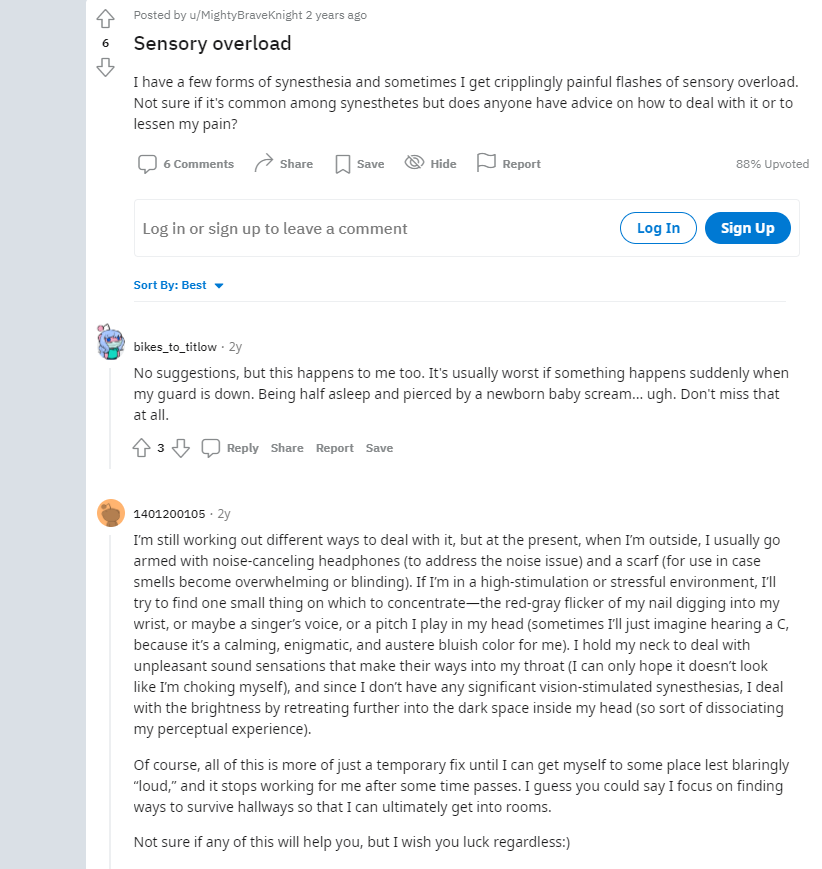
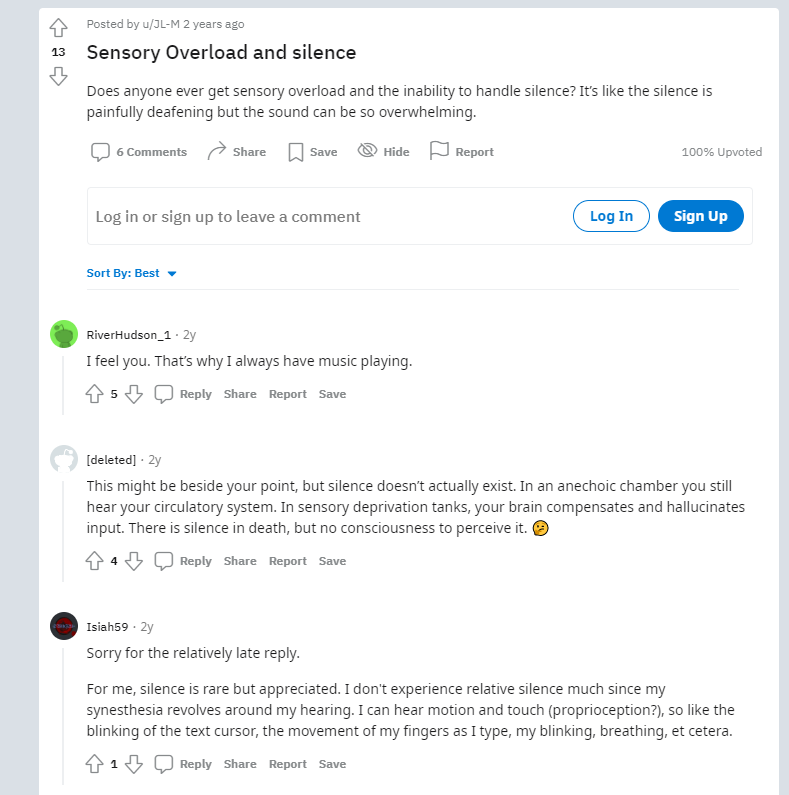

Dissertation 3.
Is synesthesia a part of sensory overload?
Based on the research, synesthesia is not entirely a part of sensory overload but shows connections between two. For instance, people who experience sensory overload and synesthesia might receive more significant impacts, such as feeling or seeing colours and sounds more exaggeratedly. However, the situation doesn’t mean synesthesia is part of the sensory overload, and there is no study proof that one is the cause of another.
In conclusion, I noticed a problem after writing dissertation 3: I need a more specific disorder to connect synesthesia and sensory overload. Because on the one hand, sensory overload covers a broad range of sensory disorders, and on the other hand, synesthesia is only a condition that doesn’t have side effects on its own.
In that case, I am writing down more questions to help me find a suitable topic to research in the next stage:
Are there any more specific disorders under the sensory overload?
Is there any disorder that connects between both sensory overload and synesthesia?
Who is more likely to have both the disorder and synesthesia?
SENSORY PROCESSING DISORDER.

After narrowing the research, I finally found a suitable topic for my final major project: sensory processing disorder. I started researching synesthesia, then dived the relationships between synesthesia and mental illnesses, and finally ended with sensory disorders.
WebMD has explained sensory processing disorder in detail. See below:
WHAT IS SPD?
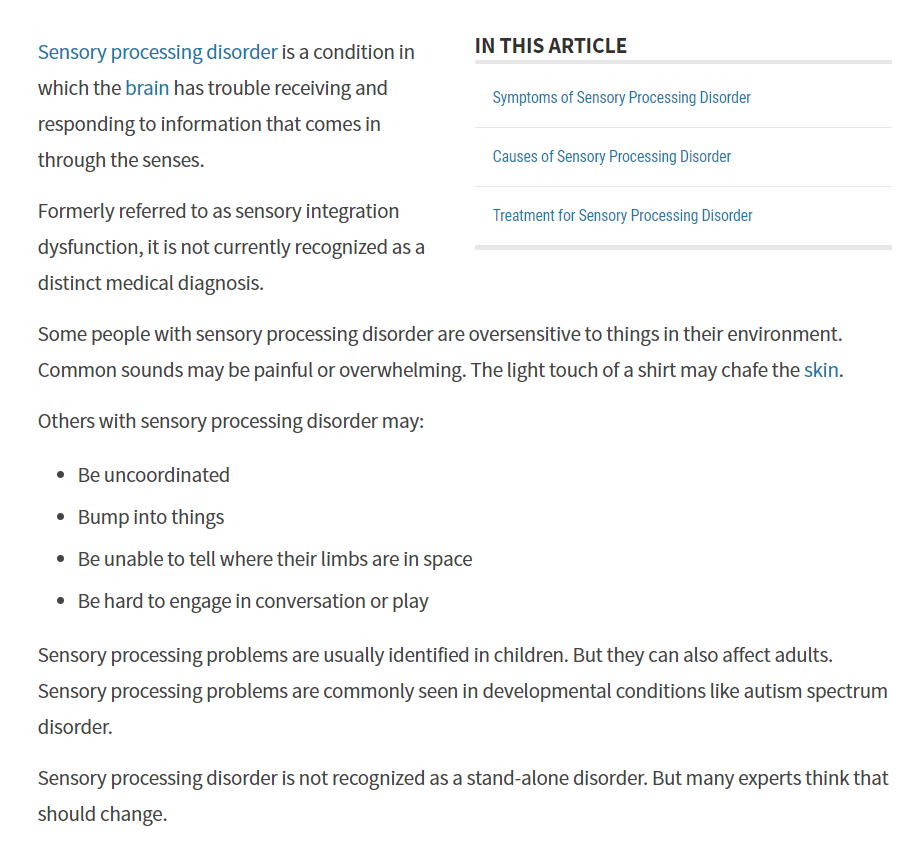
SPD is very similar to Sensory overload. However, the difference is that SPD happens when the brain can’t handle the information instead of overloaded. It means that people who have SPD may either be overwhelmed by the input or not feeling anything at all.
WHO HAS SPD?
Schaaf Roseann, Benevides Teal, Blanche Erna, Brett-Green Barbara, Burke Janice, Cohn Ellen, Koomar Jane, Lane Shelly, Miller Lucy, May-Benson Teresa, Parham Diane, Reynolds Stacey, Schoen Sarah (2010) published a paper and stated that:

Full article, see: https://www.frontiersin.org/articles/10.3389/fnint.2010.00004/full
Medical News Today also pointed out:
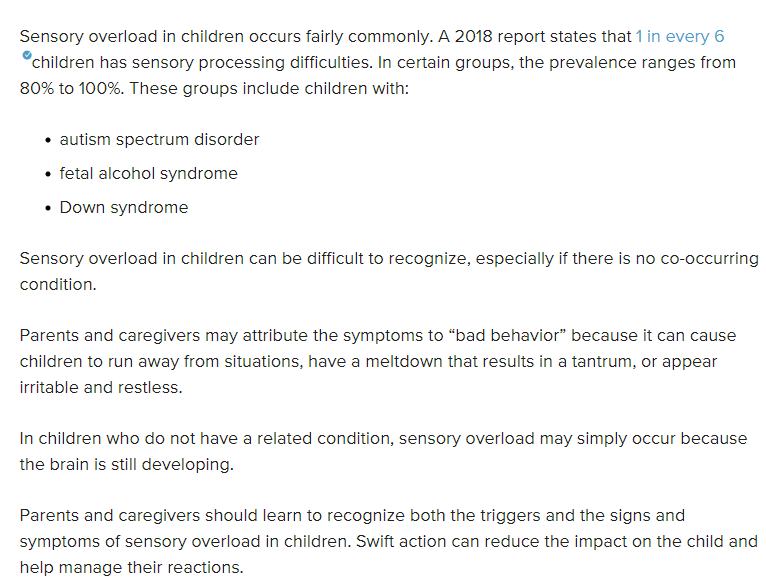
In summary, children are more likely to have sensory processing disorders compare to adults.
If I am making something based on this topic, Children with SPD will be my target group.
WHY DOES SPD HAPPEN?
Here is a short paragraph from WebMD:
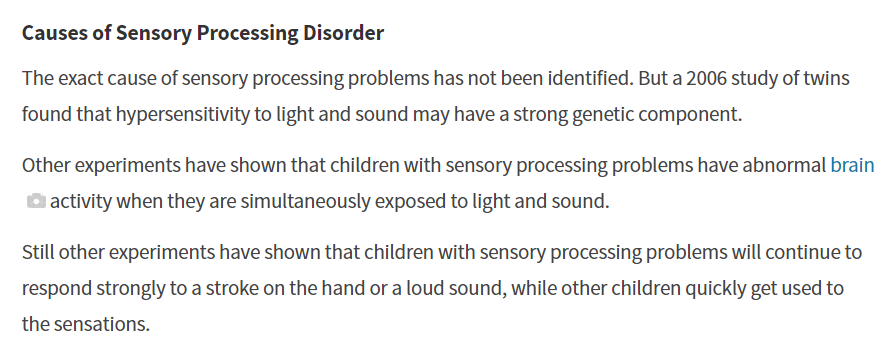
It is unclear what is the cause of SPD. However, it is usually diagnosed with other mental illnesses, for example, autism. In terms of the triggering SPD, sound, light or touching on certain textures are the cases.
WHAT IS THE ISSUE?
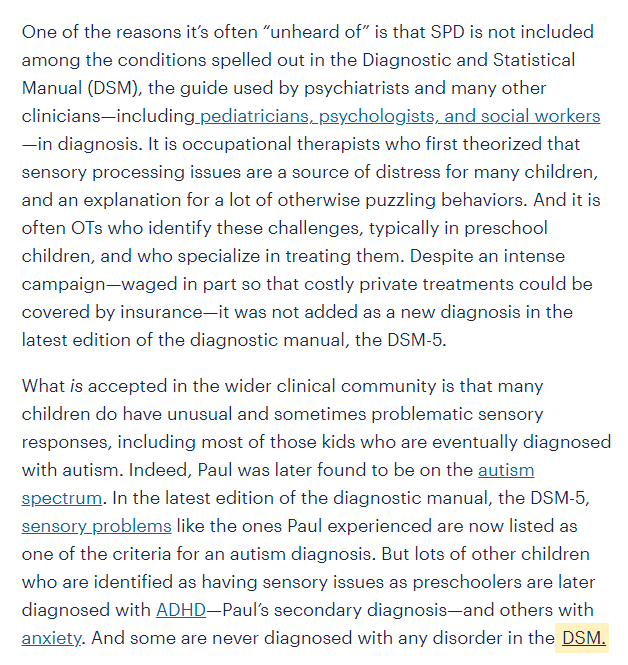
In conclusion, the issue with SPD is that people don’t see it as a ‘proper’ condition because it happens along with other mental illnesses. The situation makes it hard to separate the symptoms from other illnesses and SPD. Luckily some organisations focus on supporting children who have SPD. However, it is still an ‘unheard’ condition which people need to pay attention to.
WHERE AND WHEN TO GET HELP?
FamilyDoctor.org mentioned that the best way to get help is from trained therapists:
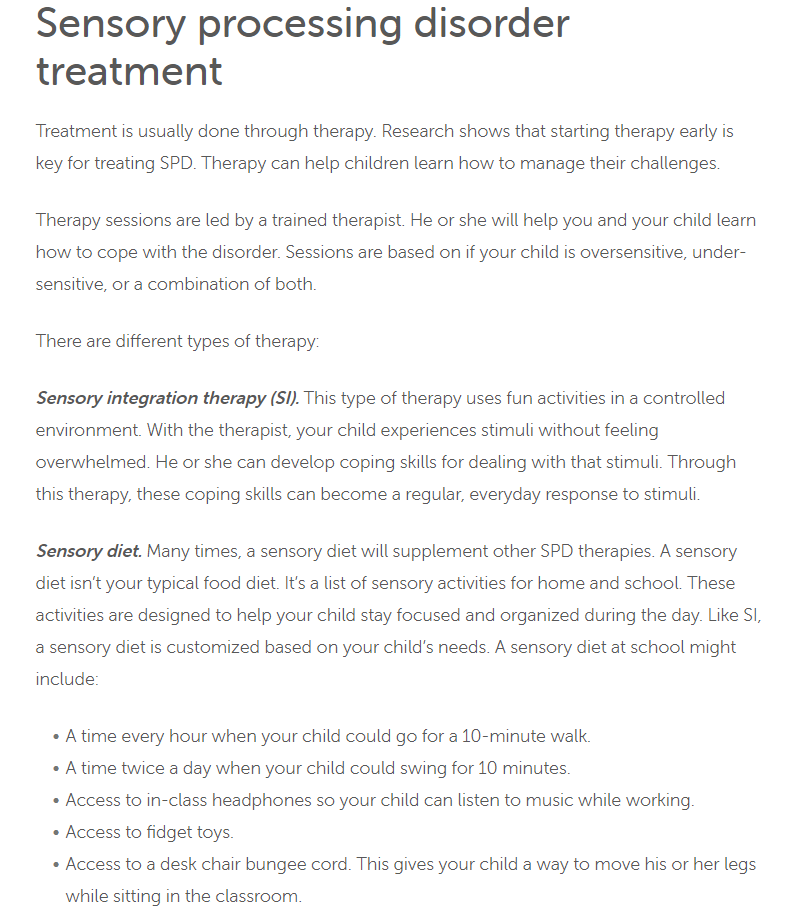
Based on the information above, the earlier children get the help they need, the better. Parents need to seek professionalists when symptoms show or the child is diagnosed with mental illnesses.
There are formal organisations that can provide exceptional help for children, and this is an organisation I found in Southampton:

The OTPractice is an organisation that focuses on helping children with SPD. See the video below:
Based on the research above, we know that these are formal organisations. They have special treatment as well as trained therapists who can provide enough help for children with SPD.
If I need some first-hand research, the OTPractice would be an excellent place to go.
HOW TO HELP?
There are many ways to help children with SPD, and here is Brenda Goodman wrote an article on WebMD:
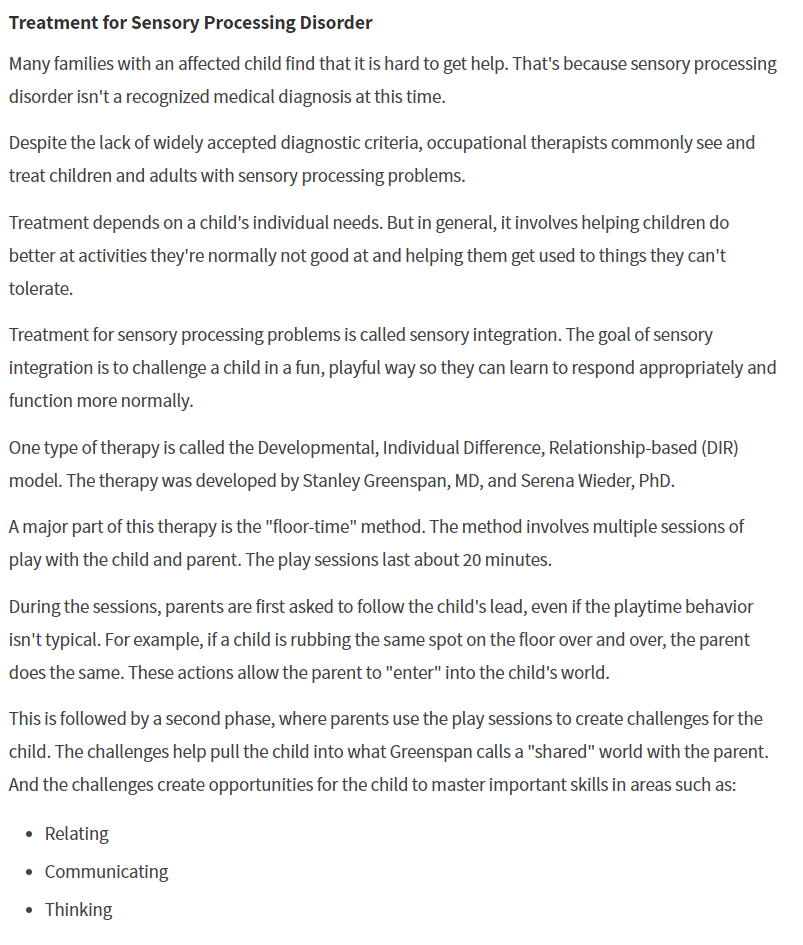
In conclusion, children with SPD require ‘care’, which involves communications and interactions with the parents. Furthermore, it is essential to let children focus on one activity, which helps them pay less attention to the uncomfortableness and let the brain process more suitably.
Here is a video shows some methods used by the therapists:
Toys, activities and games seem effective. The essence is to create engagements with the children.
It could be helpful if I design something based on these engagements.
Dissertation 4.
How to help children with SPD?
Although organisations are already focusing on children with SPD, many kids still don’t have access to them for various reasons, making it hard to seek help. Therefore, an effective method needs to be created to help children with SPD who can’t receive support from professionals. Furthermore, there is rarely any equipment designed explicitly for SPD, which could be a suitable direction for further investigation and development.
Some questions and points worth pointing out:
Where can we gather first-hand research when the disorder mainly happens to children?
Can we apply the same method/equipment to adults who are suffering from this disorder as well?
What are the existing methods/equipment designed for this disorder?
What’s the difference between professional treatment and home-based treatment?
How does it feel like when children experience both synesthesia and SPD at the same time?
When is the best time to seek help or use the methods/equipment?
CONCLUSION.
Overall, I had a decent development of the research. I started with a harmless condition called synesthesia and tried to discover problems and issues around this topic. Eventually, I headed towards the mental illness side and found severe issues that relate to synesthesia. However, I did not stick with synesthesia for long once I discovered a more suitable topic for my FMP: sensory processing disorder.
SPD is more likely to happen in children, especially those with other illnesses such as Autism spectrum disorder, fetal alcohol syndrome and down syndrome.
Based on the research above, I noticed two main issues among this disorder: firstly, the condition is still unpopular because the symptoms are usually included in other disorders; Secondly, children with SPD requires special treatment from professionals, but not everyone has access to those facilities and specialists, especially when there is an emergency.
The two issues provided me with a clear direction for my FMP: Design a method that helps children with SPD, especially when they cannot access professionals in an emergency. Furthermore, think about using this method to educate people about this condition to provide proper support when needed.
By far, I have completed the first two Cs of the 5C model. The next stage will be conceptualising the methods based on the research I have done so far.
INTERVIEW.
After concluding the problem, I then moved on to some first-hand research to make sure that I am on the right track.
I was very fortunate to find an occupational therapist in China, who happens to be my aunt’s friend. She was kind enough to offer me a phone call and talk about my project. After a brief discussion, she pointed out three main issues about my concept:
1. SPD is a very personal thing. This means that different patients will have different SPD conditions, some could be heard, some could be feeling, and you have designed the treatment to adapt to each individual, not the other way around.
2. SPD is a serious condition and requires professionals to deal with it. It is almost impossible to create a single treatment that can simply help everyone, especially when I am not working with a professional.
3. SPD is a huge topic and it is more than just feeling uncomfortable with the senses, but also the loneliness from the mental side. Therefore, to help patients with SPD, a toy or equipment is not enough.
After receiving these comments, I realised that it is impossible to create something that can just help everyone, especially when I am not a professional.
Although she cut my thoughts on this topic, the OP guided me in another direction:
There are a small number of people in the medical field who are now trying to use synesthesia(I also talked to her briefly about this topic I started with) as a method to train people’s creativity, and she thought it might be a good idea to look into that.
This suggestion was extremely helpful because, in my previous research, I was focusing on the negative side of synesthesia instead of the positive, and having it swapped actually inspired me to wonder why do people consider it as a condition instead of an ability?
With this question, I then moved on to the next phase: Conceptualise & create.
It’s funny that after all this research, I actually returned to where I started:


